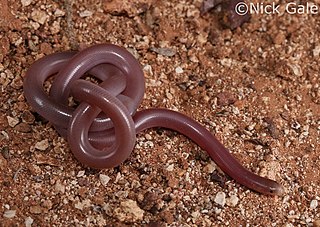Anilios australis, or the southern blind snake, is a species of snake in the family Typhlopidae. The species is endemic to Australia.
Anilios broomi, also known commonly as Broom's blind snake, the faint-striped blind snake, and the striate blind snake, is a species of non-venomous snake in the family Typhlopidae. The species is endemic to Australia.
Anilios diversus, or the northern blind snake, is a species of snake in the family Typhlopidae. The species is endemic to Australia.

Anilios endoterus is commonly known as the interior blind snake. It is one of 42 species of snake in the genus Anilios (Ramphotyphlops) from the Typhlopidae family living in Australia. These snakes appear to be blind, having vestigial eyes that are extremely sensitive to light. It is a cryptic burrowing snake that lives in tunnels underground, living mainly on a diet of ants. They are found in arid and semi-arid desert regions of central Australia and are considered endangered in New South Wales (NSW).
The long-beaked blind snake is a species of snake in the family Typhlopidae, first described in 1918 by Edgar Waite as Typhlops grypus, and endemic to northern Australia.
The Top End blind snake is a species of snake in the family Typhlopidae. The species is endemic to Australia.
The Murchison blind snake is a species of snake in the Typhlopidae family.

The robust blind snake is a species of snake in the Typhlopidae family.
Lorenz's blind snake is a species of snake in the family Typhlopidae.
The buff-snouted blind snake is a species of snake in the family Typhlopidae. The species is endemic to Australia.
The small-eyed blind snake is a species of snake in the Typhlopidae family.
The Groote dwarf blind snake is a species of snake in the family Typhlopidae. It is endemic to the Northern Territory, Australia.
The rotund blind snake is a species of snake in the Typhlopidae family.
Anilios silvia, also known commonly as the great sandy blind snake or Sylvia's blind snake, is a species of snake in the family Typhlopidae. The species is endemic to northeastern Australia.
The Darwin blind snake is a species of snake in the family Typhlopidae. The species is endemic to Australia.
The Sandamara blind snake is a species of snake in the Typhlopidae family.
The claw-snouted blind snake is a species of snake in the Typhlopidae family.
The beaked blind snake, also known commonly as Waite's blind snake, is a species of snake in the family Typhlopidae.
The brown-snouted blind snake, also known commonly as Wied's blind snake, is a species of snake in the family Typhlopidae. The species is endemic to Australia.
Anilios ganei, also known commonly as Gane's blind snake, is a species of snake in the family Typhlopidae. The species is endemic to Australia.


